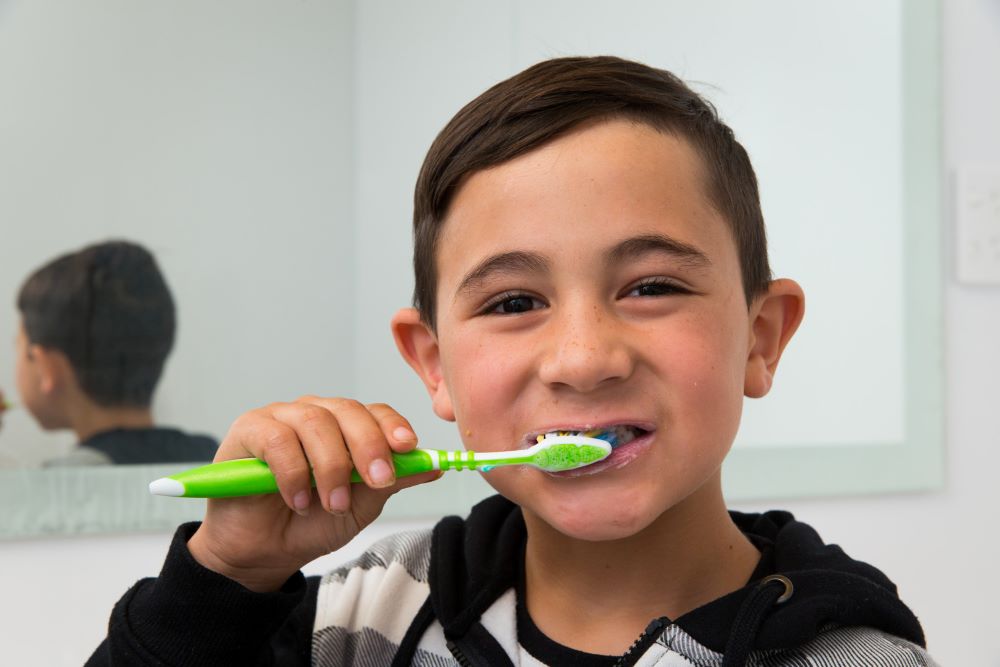Fluoride Toothpastes & Tablets


Fluoride is found naturally in soil, plants, animals and many foods. It is also found in both fresh water and sea water.
Fluoride helps prevent tooth decay in people of all ages. However, most of New Zealand’s water supplies have low levels of natural fluoride which are too low to provide dental protection.
What is fluoride?

Fluoride is found naturally in soil, plants, animals and many foods. It is also found in both fresh water and sea water.
Fluoride helps prevent tooth decay in people of all ages.
It works in three ways:
- it strengthens the tooth surface so teeth are more resistant to decay;
- it interferes with the growth of the bacteria which cause cavities;
- it helps repair the early stages of tooth decay.
Fluoride is added to most toothpastes and some drinking water supplies in order to help prevent tooth decay. Dentists or dental therapists may apply fluoride varnishes or gels to the teeth of people at risk of developing tooth decay and cavities.
Water fluoridation is when naturally occurring fluoride is topped up to the optimal level that helps protect teeth. It is a safe, effective and affordable way to prevent and reduce dental decay. It improves oral health for people of all ages and is especially beneficial for those at higher risk of poor oral health outcomes.
Occasionally some young children may receive too much fluoride when their teeth are developing. This can cause mild dental fluorosis which is when white opaque areas or flecking occurs on the tooth enamel. Mild dental fluorosis doesn’t affect the function of the tooth and can occur in children, regardless of whether they live in an area which has water fluoridation or not.
More severe forms of fluorosis are rarely seen in New Zealand but are more commonly seen overseas in areas with high levels of naturally occurring fluoride.
For more information about fluoride and water fluoridation go to the Ministry of Health, Toi Te Ora Public Health or Fluoride Facts websites.
How much fluoride is in our water?

In most of New Zealand fluoride naturally occurs in water at a concentration which is too low to provide dental protection. In areas where water is fluoridated, the optimal level of fluoride in the water supply is set between 0.7 - 1.0 mg/L (sometimes called parts per million, ppm).
Which towns have a fluoridated water supply in our region?
- Whakatāne Town
- Ōhope
- Taupō township
- Turangi
- Tokaanu
Recommendations for people living in areas with no fluoride added to their water

Use a fluoride toothpaste.
- Regular toothpaste (containing at least 1000 ppm fluoride) is recommended for all ages including children and should be used twice daily, preferably after breakfast and before bed.
- For children under 6 years: use only a smear of regular toothpaste.
- For everyone aged 6 years and over: use only a pea-sized amount of regular toothpaste.
- Toothpaste should not be eaten.
- Children should be supervised until the age of eight years when using toothpaste (to make sure they don’t eat it).
- Children and adults should spit out toothpaste after brushing their teeth, rather than rinsing their mouth with water. This leaves a small amount of fluoride toothpaste around the teeth which will help protect them.
What about fluoride tablets?

Fluoride tablets used to be recommended for everyone living in areas without water fluoridation; however they are no longer recommended.
- Fluoride tablets are not recommended for children younger than three years of age (because of the possible risk of dental fluorosis) or for pregnant women.
- Fluoride tablets may be recommended by an oral health professional for people aged three years or older who are at high risk of dental decay.
- If fluoride tablets have been recommended by a health professional, the tablets should be chewed, sucked or dissolved in a drink.
What about other professionally applied or prescribed fluoride products?

Fluoride varnishes
- May be applied by a dental therapist or dentist for people aged over 1 year who are at high risk of dental cavities.
Fluoride gels and foams
- May be applied by a dental therapist or dentist for people only if they are aged 6 years and over and are at high risk of dental cavities.
Fluoride mouth rinses
- May be prescribed by a dentist for dental caries control for people aged 6 years and over at high risk of developing dental cavities.
Recommendations for people living in areas with fluoridated water supplies (where fluoride has been added to the water supply)

Use a fluoride toothpaste.
- Regular toothpaste (containing at least 1000 ppm fluoride) is recommended for everyone aged 6 years and above. Use only a pea-sized amount of toothpaste.
- For children under 6 years, a children’s toothpaste (containing less than 1000 ppm fluoride) may be used. Use only a smear of toothpaste.
- Teeth should be brushed twice daily, preferably after breakfast and before bed.
- Toothpaste should not be eaten.
- Children should be supervised until the age of eight years when using toothpaste (to make sure they don’t eat it).
- Children and adults should spit out toothpaste after brushing their teeth, rather than rinsing their mouth with water. This leaves a small amount of fluoride toothpaste around the teeth which will help protect them.
Fluoride tablets, fluoride mouth rinses, and professionally applied fluoride varnishes, gels and foams are not recommended unless advised to by a health professional.
For more information on the use of fluorides, please refer to:
- Ministry of Health (NZ Guidelines Group) 2009 Guidelines for the Use of Fluorides
- Ministry of Health: Fluoride and Oral Health
For more information about oral health, please refer to:
- Local oral health services
- Teeth and Gums - Ministry of Health
- Healthy Smiles - New Zealand Dental Association





